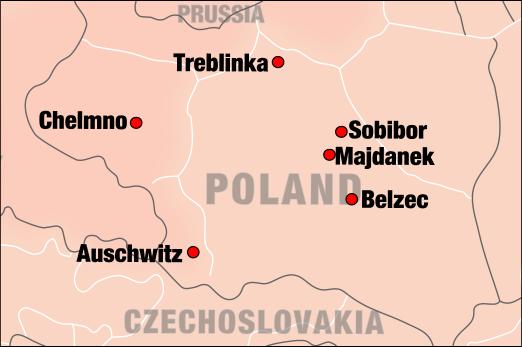SOBIBOR
[back]
Holocaust
revisionism
See: Auschwitz-Birkenau
Belsen
Belzec Buchenwald Dachau
Mauthausen
Treblinka US based Camps
Allied Camps
The Alleged First
Gas Chamber Building at Sobibór
Sobibor Strangeness – A small compendium by Thomas Kues
The Ground Water
Level at Sobibór 1942-1943
Witness Accounts By
Former Sobibor Prisoners, Part 1
Witness Accounts By
Former Sobibor Prisoners, Part 2
Witness Accounts By
Former Sobibor Prisoners, Part 3
Thomas Blatt Sobibor
Fraud
Witnesses
Thomas Blatt
Jacob Biskubicz
Moshe Bahir
Hershel Zukerman
Ada Lichtman
Itzhak Lichtman
Harold Werner (Herschel Zimmermann)
Chaim Trager
Quotes
it is a mystery why the SS construction staff, who reportedly visited
the future camp site already in late 1941 (Schelvis,
p. 27) would have chosen an area dominated by marshland for an extermination
camp where tens if not hundreds of thousands of bodies were to be buried.
Sobibor Strangeness – A small compendium by Thomas Kues
All photographs of heaps of corpses were taken in Western camps around the
end of the war, such as Dachau, Bergen-Belsen, and Buchenwald, where historians
now agree no mass murders took place. Significantly, there are no such
photographs taken at the camps in which mass murder is alleged to have occurred
(Auschwitz, Treblinka, Belzec, Sobibor, Chelmno, Majdanek.) These eastern camps
were all in areas which came under Soviet control at war's end. It is very
telling that the Soviets released no pictures of mass graves or heaps of corpses
and allowed no journalists, medical professionals, or other experts to examine
the camps. Since the end of the 1980s.
FAQ about Revisionism by
Germar Rudolf
Sobibor, Belzec, Majdanek. As in the case of Treblinka, it
would have been impossible in Majdanek or Belzec to keep any mass murder
secret; the close proximity of settlements and roads, and the
cultivation of surrounding farm land right up to the camp fences, saw to
that. In no case is there any evidence for mass graves or burning pits.
Babi Yar The ravine of Babi Yar underwent no noticeable changes in
topography or vegetation up to the end of the War. There are no signs of
human intervention during the time of German occupation. There was no
human activity there at the time of the mass cremations attested to by
the witnesses. AIR PHOTO EVIDENCE by JOHN CLIVE
BALL
Felderer found no material evidence at Sobibor to support the death camp
allegation. He again made tests of trees alleged to have been planted by the
Nazis, and found them to have been planted in the late 1960s. This was later
confirmed by a general who lived in the area. (19-4510)
[Ditlieb Felderer]
The 'False News' Trial of Ernst Zündel -- 1988
13: Sobibor Burial Space: Let's put it this
way, you can't bury the equivalent to the stadium spectators of the Rose Bowl
Game in two pits not much bigger than the chicken coop, and then sentence
someone to life imprisonment based on "the evidence." Something just isn't
right.
ONE THIRD OF THE HOLOCAUST
Odilo Globocnik (b. 1904) was the SS and Police Leader of
the Lublin District of the General Government and responsible for the
construction of the alleged “pure extermination camps” Belzec, Sobibor,
and Treblinka. According to most accounts, Globocnik allegedly poisoned himself
with a cyanide capsule just after being captured by British troops in Austria on
May 31, 1945. Other sources claim he was killed by partisans or Jewish
“avengers” in May or June 1945.
Franz Paul Stangl (b. 1908) served as commandant of Sobibor from March
to September 1942, and as commandant of Treblinka from September 1942 to August
1943. After the war he was briefly interned but released and fled to Syria . In
1951 he and his family migrated to Brazil , where Stangl, living under his own
name, worked at a Volkswagen factory. He was arrested in 1967 and extradited to
West Germany , where he was sentenced to life in prison in 1970. While awaiting
appeal he met and talked to Jewish journalist Gitta Sereny, who later published
alleged transcripts of the conversations in her book Into that Darkness
(1974). On June 28, 1971, the day after their last conversation, Stangl suddenly
died, allegedly from a heart attack.
Gustav Franz Wagner (b. 1911) was reportedly deputy commandant at
Sobibor. After the war Wagner migrated to Syria and later in the early 1950’s to
Brazil , where he lived under his own name, working as a farmhand. After Simon
Wiesenthal initiated a hunt for a man falsely identified as him, the real Wagner
voluntarily handed himself over to the Brazil special police in Săo Paulo , on
May 30, 1978. According to an article in the newspaper Folha de Săo Paulo,
June 2, 1978, Wagner had stated to the police: “I never saw any gas chamber at
Sobibor” ( Eu nunca vi nenhuma camara de gas em Sobibor). On June 22,
1979, the Rio Supreme Court dismissed all claims for Wagner’s extradition. On
October 30, 1980, Wagner allegedly committed suicide by stabbing himself to
death in the bathroom of his rural home. The circumstances of the suicide have
been deemed suspicious even by some exterminationist writers. Brazil citizen and
former Sobibor inmate Stanislaw Szmajzner, who “confronted” Wagner at the time
of his arrest, has let out that he “believes” that Wagner was in fact killed by
Jewish “avengers” (Die Zeit, October 11, 1991). The author is currently
researching the Wagner case together with local Brazilian revisionists.
Kurt Bolender (b. 1912) was another SS posted at Sobibor. When arrested
in 1961, he initially denied killings at the camp. He is alleged to have
committed suicide by hanging on October 21, 1966, just before his sentence was
pronounced. According to the American magazine Time, Bolender left behind
a suicide note stating that he was innocent.
A Brief List of the Conveniently Deceased by Thomas Kues
